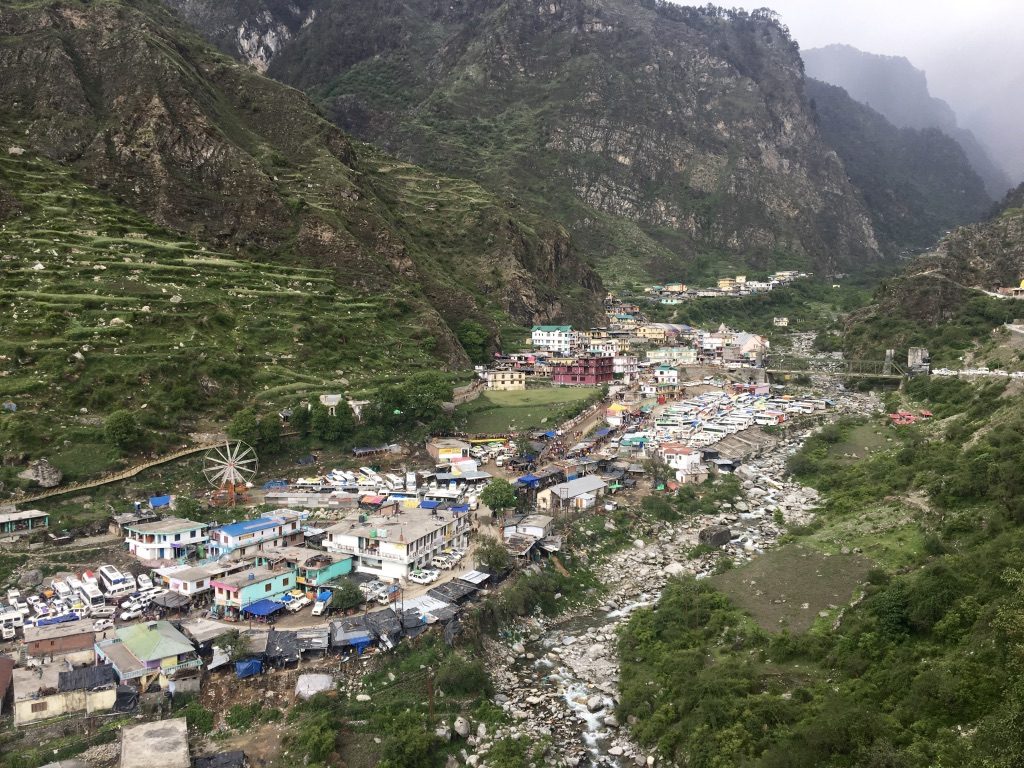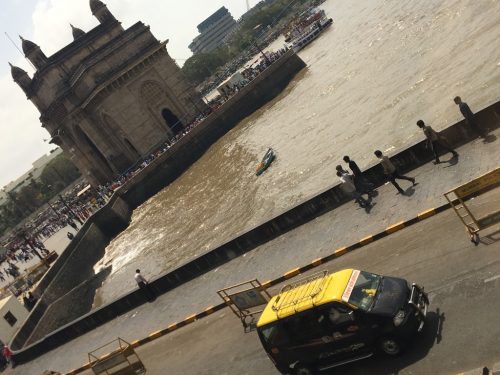
by Monica Mehta – Follow @browngirlmag
Note:*All images courtesy of Monica Mehta
5.22.17
Kharsali Village
Janiki Chaddi – city near Yamnotri
State of Uttarakhand
India
We woke up at 5 AM after a mere 2 hours of sleep to embark on our journey through the mountains to Yamnotri. The car ride was typical India – a single lane road with two-way traffic and no painted lines, carved out of the side of a mountain, a severe drop-off, and no guardrail to speak of. There were innumerable towns that lined the highway, hosting colorful buildings and tea-stalls and Maggie shops (aka Indian ramen), catering to the thousands who traveled these roads between May and June.
We winded through the towns, honking at foot traffic of people, cows, and horses. We passed many school children in uniforms and tightly braided hair, many with light-colored eyes and strikingly beautiful features common in northern Indians. The views become more spectacular as the hours pass and ultimately, in the distance – we saw enormous, snow-capped towering mountains over the clouds. The Garhwal Himalayas.
At last, we enter Kharsali Village, a neighborhood on a hill adjacent to Janki Chatti, the town where the Yamuna River begins. Our little car struggled up the unpaved, muddy path to our hotel, a rickety 2-story metal building painted mauve, with a grandfatherly fellow and two young boys waving us in. When grandfather told us that our contact wouldn’t be back until nightfall so we should just relax, I became worried that I wouldn’t be able to fulfill my duty. We sat with the boys; sipped perfectly made chai made with yak milk, and stared at the mountains while wondering what to do. The skies rumble above.
Suddenly, I summoned my father’s spirit and realized we can do this alone. We geared up. I grabbed dad’s backpack that now carried his ashes.
[Read More: ‘To India, For Dad: Dealing With The Loss of a Parent – Part I]
We took the older boy with us and walked toward the river. We used broken Hindi, bits of Gujarati, English and hand gestures to signal to the kid that we need a Hindu priest. He led us to a tent, from which a man emerges – a sneaker-wearing, 30-something-year-old pandit wearing a lavender colored wool scarf over his kurta. I knew it immediately. This is our guy.
He ducked into another tent and quickly reappeared with a flat metal dish containing the requisite ingredients: a small brightly colored yellow shall, two red bangles, yellow and white powders, a bit of rice, a dia, and incense. We walked down a muddy path toward the riverbank. I slipped then regained footing quickly. We approached the shallow, rocky, and rapidly moving Yamuna River flowing from the mountain and set up there.
The priest recited Sanskrit scriptures from The Bhagwad Gita as we conducted rituals using river water, rice, and yellow powder. We put a tikka on the small Ganesh Statue that I brought from New York, drank a palm full of the river water, and ultimately, while reciting my father’s name, threw the ashes into the rapidly flowing river. He loosened rocks below for the ashes that were trapped, and they slowly disappeared into the swirling water.
He gave us red markings on our foreheads and the ceremony was complete. He asked to confirm, “Did you eat?” meaning – did you drink the river water, to which I said yes. Finally, he asked me to describe my father so he can pick a stone to match. So I told him, “mentally strong.” He picked a glistening, dense, perfectly formed black stone and we placed it among other stones in an indentation in the wall of the Riverbank.
After wandering back, we enjoyed a nourishing dinner of hot local vegetables. The night was freezing so we doubled our quilts and finally slept – not deeply but sufficiently. When in far-off places, my mind wanders to the known. I am on a New York City subway when the 4 AM alarm rings.
Day 8
5.25.17
Mumbai
My complicated relationship with India throughout my life has come to a turning point and we are getting along much better. I feast on fresh watermelon juice, masala dosa, and chai while reflecting. This is the city in which my dad grew up and certain names and places bring back memories with him: Flora Fountain, Nariman Point, and Victoria Terminus Station – to name a few. The old, somewhat crumbling architecture of proper Mumbai is still intact, interlaced with towering new architecture. The Gateway of India still stands proudly surrounded by visitors looking upon its majestic height and design, as I did many times on previous trips to India. It may symbolize British occupation (they both entered India and left through this arch), but not to me. I think of family vacations to India as a child. My parents were just here.
Meeting with relatives left me with a sense of tremendous belonging. In India, blood is thicker than water and my family welcomed us, cooked for us, and asked us to stay in better touch. When I asked about their family members about the afterlife – they didn’t theorize or wax philosophically. They answered very matter of factly. Some believe that my parents are now with God (or in the feet of the God, Srinagi). Some said that our human lives are our final lives on this earth prior to nirvana. Some believe that we just don’t know and should leave it at that.
One cousin told me that I should focus on the living, not the dead. And another older aunt/uncle of B’s told us that they do in fact, believe in reincarnation. They went on to say that those with abruptly shortened lives (like when children pass away) are here for unfinished business. And that we interact with lost contacts in their new form, all none-the-wiser. The diversity of opinions on the topic is somewhat surprising. There is no “Indian answer” and at least for my family, who are very practical people, there’s no point in obsessing over it. There is no answer here, but perhaps a lesson nonetheless.
 Monica is a quintessential Gemini, straddling worlds of both art and science. She works as an infectious disease clinical pharmacist, with interests in healthcare quality, access to medicines, & antimicrobial resistance. She previously worked in film and wrote several screenplays including Art=Love2 (2010) and made a documentary in Sierra Leone called Batiloh’s Plan (2010). More recently, she has been doing more blogging and spoken word. Monica resides in New York City with her husband and dog, Caju.
Monica is a quintessential Gemini, straddling worlds of both art and science. She works as an infectious disease clinical pharmacist, with interests in healthcare quality, access to medicines, & antimicrobial resistance. She previously worked in film and wrote several screenplays including Art=Love2 (2010) and made a documentary in Sierra Leone called Batiloh’s Plan (2010). More recently, she has been doing more blogging and spoken word. Monica resides in New York City with her husband and dog, Caju.





